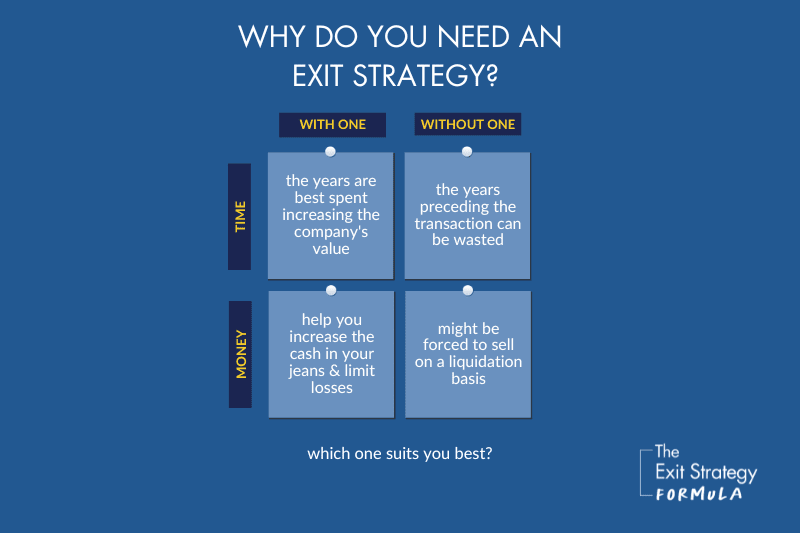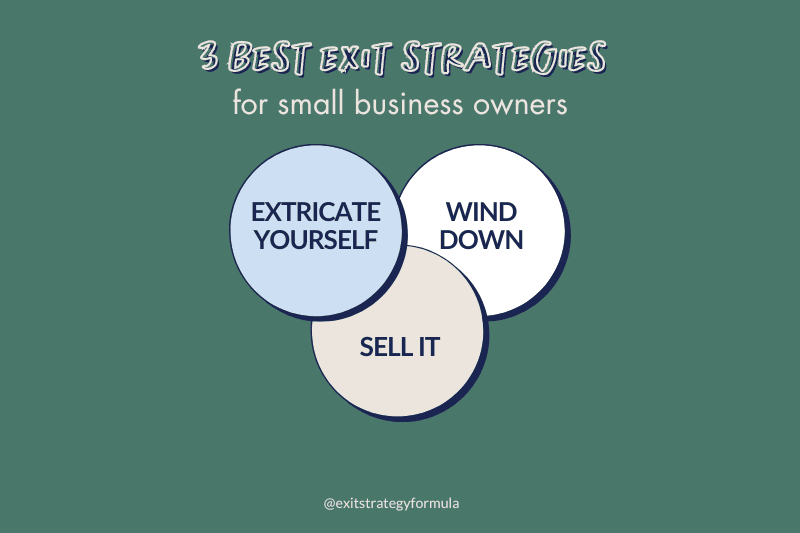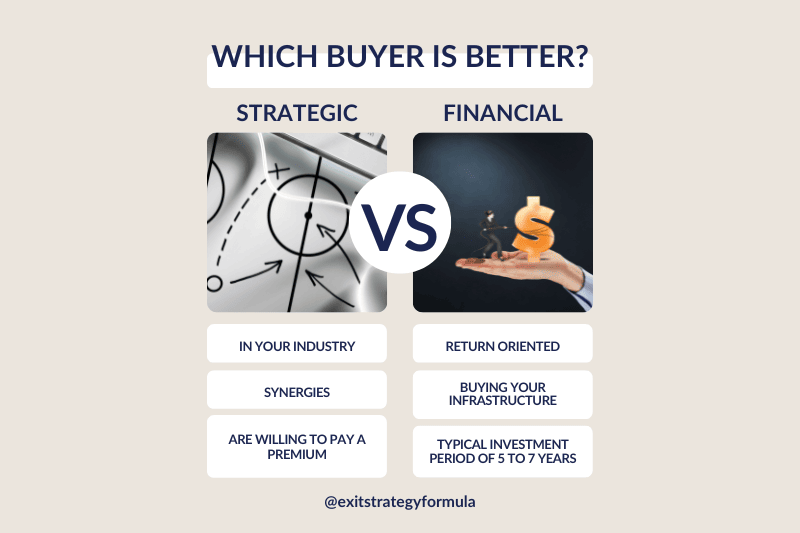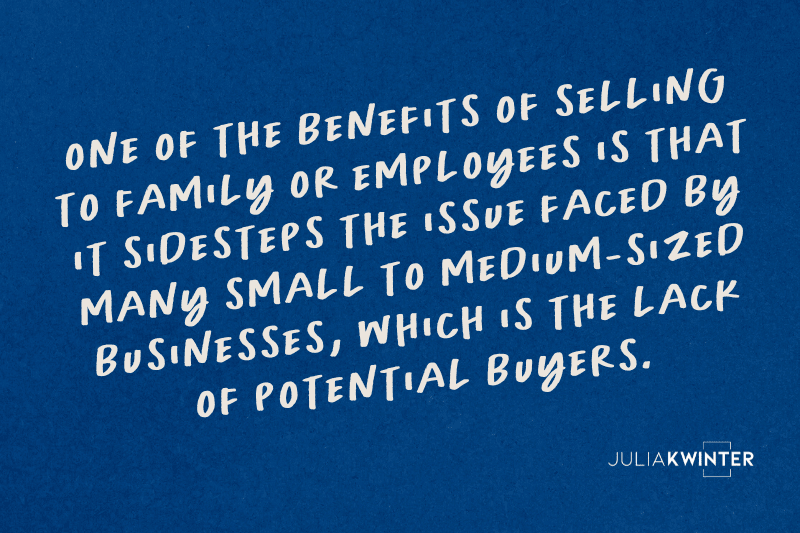
3 Exit Strategies for Small Businesses | The Exit Strategy Formula
Table of Contents
What is a company exit strategy?
Benefits of having an exit strategy
Why do you need an exit strategy?
What to consider for small business exit strategy planning
What to consider for small business exit strategy planning
3 Types of Exit Strategies for Small Business
How to decide which of the exit strategies is right for you?
Why should I sell my business?
Do I sell all or part of my business? Consider these questions:
How do you calculate company valuation?
How do I prepare my small business for implementing an exit strategy?
What is a company exit strategy?
Investopedia defines an exit strategy as "a contingency plan that is executed by an investor, trader, venture capitalist, or business owner to liquidate a position in a financial asset or dispose of tangible business assets once predetermined criteria for either has been met or exceeded."
Put another way, in a small business context, an exit strategy is the owner's exit plan, how the business owner will extricate themselves from the company and how they will (hopefully) realize a gain on their investment.
Common exit strategies
Exit strategies that people talk about include:
merger (two existing companies become one)
acquisition (one company buys another company outright)
initial public offering (IPO aka going public)
sell to a family member
wind up the company
This article focuses on the feasible exit strategies for small business owners.
Benefits of having an exit strategy
Why do you need an exit strategy?
The process of selling a company takes a significant amount of time; there's the time to complete an actual business sale transaction, plus the years preceding a transaction which is best spent increasing the value of the business operations. There are two significant downsides to exiting without an exit strategy:
Without an exit plan, the years preceding the transaction can be wasted. Those years are best spent increasing the company's value in the eyes of potential future investors.
Without an exit plan, if you sell the business, you may be forced to sell the assets at a lower-than-market rate. Having an exit plan helps you limit losses or force a liquidation of your business.

Investopedia defines an exit strategy as "a contingency plan that is executed by an investor, trader, venture capitalist, or business owner to liquidate a position in a financial asset or dispose of tangible business assets once predetermined criteria for either has been met or exceeded."
Put another way, in a small business context, an exit strategy is the owner's exit plan, how the business owner will extricate themselves from the company and how they will (hopefully) realize a gain on their investment.
An exit strategy is a common component of a business plan. Still, most businesses don't operate with or abide by a current business plan, and the inclusion of an exit strategy in a business plan is outside this article's scope.
What to consider for small business exit strategy planning
Investopedia defines an exit strategy as "a contingency plan that is executed by an investor, trader, venture capitalist, or business owner to liquidate a position in a financial asset or dispose of tangible business assets once predetermined criteria for either has been met or exceeded."
Put another way, in a small business context, an exit strategy is the owner's exit plan, how the business owner will extricate themselves from the company and how they will (hopefully) realize a gain on their investment.
Common exit strategies
Exit strategies that people talk about include:
merger (two existing companies become one)
acquisition (one company buys another company outright)
initial public offering (IPO aka going public)
sell to a family member
wind up the company
This article focuses on the feasible exit strategies for small business owners.
What to consider for small business exit strategy planning
3 Types of Exit Strategies for Small Business
Most small business owners think they have two options regarding their exit strategy: sell it, or wind it down/liquidation. But I want to present a third option that is likely the most profitable and preferred exit strategy.
There are three common types of exit strategies entrepreneurs have when they want a business exit:
sell it
stop the company's operations, wind down the company and sell off its assets (liquidation)
keep it but extricate themselves from day-to-day operations

Suppose you need help finding the right buyer and can't sell your company but want to part with it. In that case, an exit strategy worth considering is liquidation – selling what you can and shutting down the business as quickly as possible. Of course, this option likely results in the least cash in your jeans. If this is the case, you can try to make your company's financials more attractive or find someone willing to work in your company for the express purpose of selling it to them.
Exit Plan
How to decide which of the exit strategies is right for you?
If you don't have any co-investors with their views to juggle, the best exit strategy decision is both personal and business-dependent.
Exit Strategy Considerations
If you decide to sell your company, what should be considered? That depends on whether this is a high-growth enterprise like a tech company or a non-tech company. If you've had outside investment or incentivized your management team with stock options, investors and your staff will want an exit or liquidity event within 5 to 10 years. If not, the exit timing is up to you.
The other key consideration is whether to dispose of all or part of the company. Depending on the industry and your other financial opportunities, there can be considerable advantages to keeping a portion of the business. You may want to exit the business altogether, or you may want to give up control but maintain an ownership interest.
You can sell it to known parties, such as the management team or family members, or you can sell it to third parties. When selling to management team or family members, you want to be fair with your value. You want to avoid creating ill will by negotiating an unfair price when dealing with longstanding employees or family members.
Whether you merge with another company or are outright acquired by a larger company, there is no "best" exit strategy for all businesses. Your objectives will determine your best exit, the value you can convey to the market and the opportunities available at any given time.
Different Types of Buyers
There are family buyers and third-party buyers. Third-party buyers are categorized into two groups:
strategic buyers
financial buyers

Strategic buyers may be your competition or someone else in your industry looking to vertically integrate, such as a supplier or one of your customers. Strategic buyers may be interested in buying your business because there are:
Technology they want to buy
Talent they want to buy
Customer base they want to buy
Profits they want from vertically integrating
Competitors will have synergies (which are costs they can cut); as such, they benefit from cost savings other buyers can't realize.
The strategic buyer wants your entire business - 100% ownership and control. Typically strategic buyers are willing to pay a premium to have you exit quickly, so they can integrate your business with their own or use yours as the platform for future growth in your industry.
Financial buyers are looking for profitable businesses that have cash flow but may not yet be the dominant player in their market space. They will pay less than strategic buyers, usually around 15-20% of your business' value.

One of the benefits of selling to family or employees is that it sidesteps the issue faced by many small to medium-sized businesses, which is the lack of potential buyers.
The challenge when you dispose of a small to medium-sized business is that the pool of potential buyers is smaller. It is often limited to buyers in a specific town or city. If you have a very large business, the available pool of buyers is international in scope. If you go to market your business and there are only one or two potential buyers, you cannot create an auction situation to drive up the selling price. Business owners in this situation can find themselves unable to sell their business for what they think it's worth. By selling the business to a family member or employees, you can agree on a fair price because family has to keep being family after the transaction, and owners feel obligated to be fair to their employees.
No matter whom you divest to, to get the highest value for your business, subject to the type of business, you should be prepared to stick around for 3 years to transition the business to new owners. If you're not willing to stick around, some buyers may not be interested, and you want many buyers to be interested in ensuring you can get a high value for your exit.
Why should I sell my business?

Asking yourself why you would want to sell is an essential step before you go to sell, as it will likely arise when considering the price someone is willing to pay for your business. Why would you want to sell to exit as a sole business owner?
You may need to deliver an exit event to investors and employees.
You may want to pass the business down to your kids, creating a legacy asset.
If you have employees interested in taking over the company, you can exit the business and let them buy an ownership stake from you. Management buyouts are a popular and often successful exit strategy given that the new owner is capable of taking the reigns right off the bat, having been an employee with historical institutional knowledge, likely over the long term.
Suppose you want to do something else with your time. You may have been running the company for a while, and now it's just time to sell the company as part of a succession plan.
You don't care for the work anymore – Often, entrepreneurs do not enjoy running a business but enjoy doing their job. In this case, it may be time to exit your company and take a new position within another company that provides those things you love about entrepreneurship without the burdens of holding an ownership stake in a firm.
If you want to do something else with the potential proceeds.
There may be another investment opportunity you wish to pursue, or you might have an idea for a new business.
If there are headwinds in the industry or market that you don't want to face and feel other investors:
Won't be turned off by the headwinds causing a low price, or
Could better face the headwinds.
Someone is willing to buy the business at a higher valuation than you think it's worth, and you can't pass up the substantial profit you can make.
Why not sell your business?
What else will you do with the money? This is a very real question coupled with, what else will you do with your time?
You can become a passive investor in your business. Suppose you determine you would rather extricate yourself from the day-to-day operations of your business as your exit strategy. In that case, you can earn income as an investor rather than as an operator. By delegating your role in the day-to-day operations to someone else, the overall profits of the business may go down because you have to pay someone for that role. However, you can spend less time in the business and will still reap the financial benefits of being an investor in your business.
Weighing the pros and cons of the potential exit strategies is something every business owner should do well before a sale is contemplated.
Frequently Asked Questions
What is M&A?
M&A means mergers and acquisitions. The two types of transactions are often grouped as possible sales strategies.
Do I sell all or part of my business? Consider these questions:
How much money are you looking to take off the table?
Do you need the cash proceeds for the entire business, or are you happy to keep some cash invested in the business because of the potential upside if the business continues to grow in value? Do you have non-compete clauses that preclude you from doing similar work if you exit the business?
Are you ok giving up control and working with other people in the business you may have started?
How do you calculate company valuation?
One of the essential exit strategy considerations when selling a business is how much you should sell it for. The problem is that there isn't one simple method for determining the value of your business. There are different approaches to business valuation, and taking a deep dive is necessary.
How do I prepare my small business for implementing an exit strategy?
Preparing your small business for an exit strategy involves careful planning and execution. It's crucial to start early and follow a structured approach. We recommend following these 7 Steps to Plan Your Business Exit Strategy, which include assessing your business's value, improving operations, researching potential buyers, getting financials in order, building a strong team, and creating a detailed timeline. By following these steps, you'll be better positioned to maximize your business's value and ensure a smooth transition, regardless of which exit strategy you choose.
What next?
To discover if now is ACTUALLY the "right time" to sell your business and get a 3-Step Action Plan to set you up to sell your business with confidence when the time IS right, try out this FREE ASSESSMENT.
© 2022 Julia Kwinter. All Rights Reserved.


